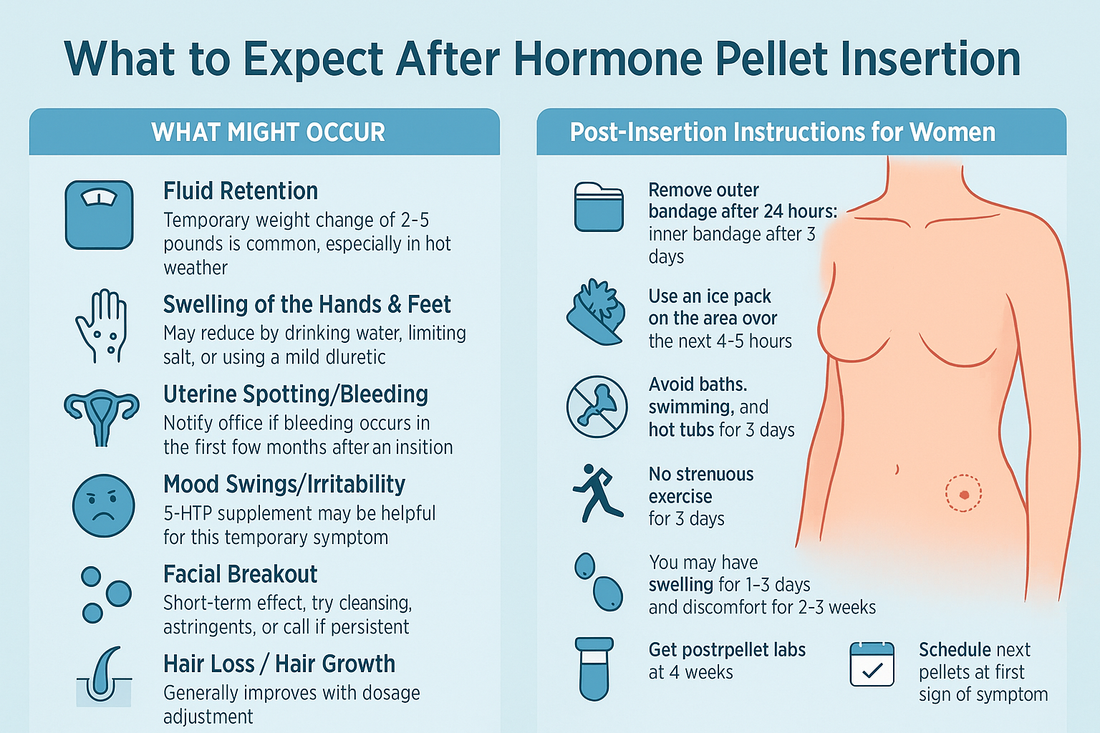What Women Should Expect After Hormone Pellet Insertion: A Patient’s Guide
Hormone pellet therapy is one of the most effective ways to restore hormonal balance and relieve symptoms such as fatigue, mood swings, hot flashes, weight gain, low libido, and brain fog. At Revolution Health, many of our patients choose pellet therapy because it provides a steady release of hormones over time—without the daily hassle of creams, patches, or pills.
While pellet therapy is safe and effective, it’s important to know what to expect after your procedure and how to care for yourself during the healing period. This guide will walk you through:
-
Common experiences after a pellet insertion
-
What symptoms may temporarily occur
-
Post-insertion care instructions
-
When to follow up with labs and repeat procedures
Our goal is to help you feel confident, prepared, and supported on your journey to hormone balance.
What Happens After a Pellet Insertion?
Pellets are tiny, rice-sized implants inserted just under the skin (usually in the hip or buttock area). They release a steady dose of hormones such as testosterone, estrogen, or a combination, depending on your needs.
After insertion, your body begins adjusting to the new hormone levels. During the first four weeks, a significant hormonal transition occurs. This adjustment period is temporary, but certain symptoms may develop as your body reaches a new balance.
Common Symptoms After Pellet Insertion
While not everyone experiences side effects, here are some things that may occur in the weeks following your procedure:
1. Fluid Retention
-
Testosterone stimulates muscle to grow and retain water.
-
This may result in a temporary weight change of 2–5 pounds.
-
More common after the first insertion and during hot, humid weather.
2. Swelling of Hands & Feet
-
Common in warm weather.
-
Tips to reduce swelling:
-
Drink plenty of water
-
Limit salt intake
-
Try cider vinegar capsules (available at health food stores)
-
Ask our office about a mild diuretic if symptoms are bothersome
-
3. Uterine Spotting or Bleeding
-
May occur in the first few months, especially if you’re prescribed progesterone but are missing doses or taking an insufficient dose.
-
This does not necessarily mean there’s a uterine problem.
-
It often reflects the uterus releasing tissue that was already present before the pellets.
-
Notify our office if this occurs so we can adjust your treatment if necessary.
4. Mood Swings or Irritability
-
More likely if you were severely hormone-deficient before starting therapy.
-
Symptoms usually disappear once hormone levels stabilize.
-
5-HTP supplements (available at health food stores) may help temporarily.
5. Facial Breakouts
-
Some women may notice pimples if they were very deficient in testosterone.
-
This usually lasts only a short time.
-
Tips:
-
Cleanse the skin regularly
-
Use astringents or toner
-
If symptoms persist, contact our office for additional solutions
-
6. Hair Loss
-
Rare, usually in women who convert testosterone into DHT (dihydrotestosterone).
-
Adjusting your dose often reduces or resolves the issue.
-
In rare cases, prescription medications may be needed.
7. Hair Growth
-
Testosterone may increase hair growth on the chin, chest, nipples, or lower abdomen.
-
You may also notice you need to shave legs or arms more frequently.
-
Dosage adjustments can usually help reduce this effect.
Post-Insertion Care Instructions for Women
To ensure proper healing and minimize complications, follow these steps after your pellet procedure:
Bandage Care
-
Your insertion site is covered with two layers of bandages.
-
Remove the outer pressure bandage after 24 hours (or sooner if it gets wet).
-
The inner layer (waterproof foam tape or steri-strips) should be removed after 3 days.
-
Activity Guidelines
-
Apply an ice pack to the area for about 20 minutes a few times over the first 4–5 hours.
-
Avoid tub baths, hot tubs, and swimming for 3 days.
-
You may shower, but do not scrub the site until it heals (about 7 days).
-
Avoid strenuous exercise for 3 days, especially activities that stress the gluteal area (running, squats, lunges, elliptical).
Healing Expectations
-
The sodium bicarbonate in the anesthetic may cause swelling at the site for 1–3 days.
-
The site may feel uncomfortable for up to 2–3 weeks.
-
Bruising, swelling, and redness are common and may last several days to weeks.
-
A small amount of pinkish or bloody discoloration on the bandage is normal.
-
If bleeding occurs, apply firm pressure for 5 minutes.
When to Call Our Office
-
If bleeding does not stop after applying pressure.
-
If you notice pus or discharge from the insertion site.
-
If swelling, redness, or pain seems excessive or worsens over time.
Important Reminders
-
Post-Pellet Labs: Schedule blood work 4 weeks after your insertion so we can evaluate hormone levels and adjust your treatment if necessary.
-
Pellet Longevity: Most women will need a repeat pellet insertion every 3–4 months.
-
Symptom Return: Schedule a new insertion as soon as the symptoms that were relieved by pellets start to return.
Conclusion
Pellet therapy is one of the most effective ways to restore hormone balance, improve energy, and reclaim vitality. The first few weeks after insertion involve adjustment as your body transitions to healthier hormone levels. Temporary side effects like fluid retention, swelling, spotting, or mood shifts are common but manageable.
By following post-care instructions, monitoring your labs 4 weeks after pellet insertion, and maintaining open communication with our office, you can ensure a smooth and successful experience with hormone pellet therapy.
If you have questions or notice symptoms that concern you, don’t hesitate to reach out to us at Revolution Health. We’re here to support you every step of the way.


